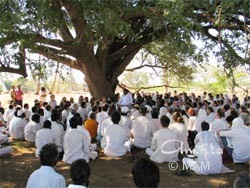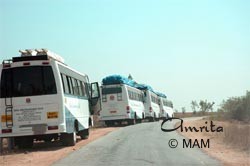18 February — Kalyan Durga, Andhra Pradesh, off SH, en route to Hyderabad from Davanagere -Bharata Yatra 2006

Leaving Karwar and heading inland to Davanagere, the lush coconut groves and backwater inlets of the coast are left behind. The highway leads through forests–dense, deep and dark. Then, moving on to Hyderabad, this too begins to fade.
The trees thin, the air becomes drier and open spaces lay claim to the land. There are long stretches of dusty red earth, cacti and solemn hills–piles of massive brown rocks. Occasionally, a boulder bigger than a house sits, precarious and surreal, on some ridge just above the highway.
In such terrain, it’s not easy to find shade for 400 people to have lunch in. But eventually it was done–an ancient tamarind tree with branches stretching far and wide. Sitting in a chair at the tree’s foot, Amma began serving lunch. When everyone had taken their prasad, Amma asked if there were any questions. An ashramite from America stood up and asked if Amma could tell him what the best way was for one to use the tour in order to gain maximum spiritual benefit.
“If the mind is travelling it’s travel, but if it is not it’s not,” Amma said.
“Wherever you are, every action should be with the remembrance of God. This yatra is a chance to serve others. Everyone in the world does not get a chance to serve others. It is grace that has given you this opportunity.”
Amma then explained that the desire to serve others is not a form of attachment, but compassion. It comes when we are able to see our self in others and see their pain, suffering and sorrow as our own.
Even though the sun reflects in 100 pots, there is only one sun.
Amma told the ashramites to try to think of the needs of the devotees who come for her darshan. She gave the example of how they can try to help them find shade and water when the programmes run long into the next day, as in Karwar or Mangalore. “For a farmer, standing in the hot noon sun may be no problem,” Amma said. “But one who has high or low blood pressure can even faint.”
Another observance that can help purify one’s mind during the tour, Amma said, is staying awake through the night in order to serve others. “If a dear friend or relative of ours is sick, we will keep awake to be with them and make sure they are not lacking any thing,” Amma said. “Similarly we should we serve the devotees.”
Amma said she knew how difficult it was for the ashramites and devotees travelling with her to regularly do meditation and archana on the tour because of how little sleep they were getting. But she said that they should try to do what they could in the time available between programmes, and in general they should chant their mantras as much as possible throughout the day.

“On the bus, it is difficult not to fall asleep,” Amma said. “But chant the sahasranama [archana] or your mantra. You may fall asleep after a hundred mantras, but that’s okay. When you wake up, resume where you left off. Again you may fall asleep, and again you should pick up where you left off. This way, even when you are sleeping, your mind will be fixed on God.” [related story]
From the standpoint of creation, our life span is maybe 80 seconds, if we are lucky. We spend 20 seconds here, 20 seconds there, and then before we know it we are gone. When one understands the transient nature of life, then he can enjoy it properly–like a short outing among friends. “Life is like a picnic,” Amma said. “It is meant to be a celebration.”
When one travels for pleasure, the mind revels in the constantly refreshed sense-objects. For such a person, travel is just what the word implies–a journey through an ever-changing progression of landscapes, people, tastes, sights and sounds. But those who are on a true spiritual pilgrimage are not distracted by such things. No matter the city, the highway or the programme venue, the Guru is the focus, the Inner Self is the focus, the changeless substratum of the changing landscape is the focus. For such a one, the yatra is not a yatra.
—Sakshi
